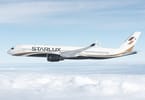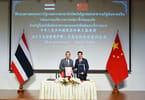WASHINGTON, DC – The FAA has released its annual Aerospace Forecast Report Fiscal Years 2016 to 2036 that finds a sustained increase in overall air travel and the use of Unmanned Aircraft Systems
(UAS).
A key portion of the forecast focuses on projections for the growth in the use of unmanned aircraft, also known as drones. The FAA estimates small, hobbyist UAS purchases may grow from 1.9 million in 2016 to as many as 4.3 million by 2020. Sales of UAS for commercial purposes are expected to grow from 600,000 in 2016 to 2.7 million by 2020. Combined total hobbyist and commercial UAS sales are expected to rise from 2.5 million in 2016 to 7 million in 2020.
Predictions for small UAS used in the commercial fleet are more difficult to develop given the dynamic, quickly-evolving nature of the market. Both sales and fleet size estimates share certain broad assumptions about operating limitations for small UAS during the next five years: daytime operations, within visual line of sight, and a single pilot operating only one small UAS at a time. The main difference in the high and low end of the forecasts is differing views on how those limitations will influence the widespread use of UAS for commercial purposes.
Looking at commercial air travel, Revenue Passenger Miles (RPMs) are considered the benchmark for measuring aviation growth. An RPM is one revenue passenger traveling one mile. The FAA forecast calls for system RPMs by mainline and regional air carriers to grow at an average rate of 2.6 percent a year between 2016 and 2036, with international RPMs projected to increase 3.5 percent a year, doubling over the forecast period. Domestic RPMs are forecast to increase by more than 50 percent over the same time. In 2015, system RPMs by U.S. carriers grew from 857 billion to 889 billion, a 3.8 percent increase.
The FAA’s NextGen program is helping to meet this consistent aviation growth. NextGen focuses on implementing technologies and procedures that utilize satellite-based aircraft navigation and phase out efficiency limitations of the current ground-based radar navigation system. For example, the environmental and economic gains of reduced fuel usage associated with NextGen advancements are projected to achieve a savings of billions of dollars in airline operational costs and achieve sustainable aviation growth.
Proven economic data that utilize sources such as generally accepted projections for the nation’s GDP are used in the FAA annual forecast, which has consistently made it the industry-wide standard of U.S. aviation-related activities. The report looks at all facets of air travel including commercial airlines, air cargo, private general aviation, and fleet sizes.
FAA AVIATION FORECAST FACT SHEET
I. 2015 SUMMARY: ECONOMIC ACTIVITY AND AIR TRAVEL
U.S. Gross Domestic Product (GDP) increased 2.6%; world GDP increased 2.4%.
Domestic mainline yields decreased 2.5% while international yields decreased 4.9% in 2015. In real terms (adjusted for inflation in FY15$), domestic yields decreased 2.9% and international yields decreased 5.2%.
•Domestic enplanements on mainline and regional air carriers increased from 669.0M in 2014 to 696.4M (4.1%) in 2015. Domestic mainline carrier enplanements increased 5.6% while domestic regional carrier enplanements decreased 0.7%. International enplanements on mainline and regional air carriers increased from 88.0M in 2014 to 89.4M (1.6%) in 2015. Mainline carrier international enplanements were up 2.4% while regional carrier international enplanements declined 22.2%.
•Domestic RPMs by mainline and regional air carriers increased from 600.0B in 2014 to 628.7B (4.8%) in 2015. Domestic mainline carrier RPMs increased 5.5% and domestic regional carrier RPMs decreased 0.3%. International RPMs by US carriers increased from 256.7B in 2014 to 260.4B (1.4%) in 2015. Total system RPMs increased from 856.7B in 2014 to 889.1B (3.8%) in 2015. Total mainline carrier RPMs increased by 4.2% while total regional carrier RPMs decreased by 0.8%.
•U.S. commercial air carriers (including passenger and cargo) reported an operating profit of $26.7B in 2015, compared to an operating profit of $16.8B in 2014. Operating revenues decreased 3.0% in 2015, while operating expenses decreased 5.3%.
•In 2015 total landings and takeoffs at combined FAA and contract towers were up 0.2% from 2014. Air carrier activity increased by 5.7% while commuter/air taxi activity decreased by 6.5%. General aviation activity dropped 0.3% while military aircraft activity dropped 0.8%.
II. ECONOMIC ASSUMPTIONS FOR FAA FORECASTS
U.S. Real GDP is forecast to increase from $16.3T in 2015 to $26.2T in 2036, an average annual rate of 2.3%. World GDP is forecast to grow at a faster pace of 3.0% over the same 21-year period, from $74.4T to $136.3T.
GDP by World Region (Average Annual Percent Growth)
World Region
Fiscal Year
Calendar Year
2015
2016
2017
2016-36
2015
2016
2017
2016-36
U.S
2.6 2.5 3.1 2.2 2.4 2.9 2.8 2.3
World
N/A N/A N/A N/A 2.4 2.7 3.0 2.9
Canada
N/A N/A N/A N/A 1.0 1.8 2.2 2.1
Europe/Afr/ME
N/A N/A N/A N/A 1.5 1.9 2.3 2.3
Latin America
N/A N/A N/A N/A 0.4 0.1 1.9 3.0
Asia/Pacific
N/A N/A N/A N/A 4.2 4.2 4.4 4.0
•Inflation is projected to increase 0.9% in 2016 and remain moderate over the remaining 20 years of the forecast period, averaging 2.3% annually.
III. AVIATION ACTIVITY FORECASTS
Mainline Air Carrier and Regionals
Total mainline air carrier and regional RPMs are forecast to increase from 889.1B in 2015 to 1.53T in 2036, an average annual rate of 2.6%. Domestic RPMs are projected to increase 4.1% in 2016 and then grow an average of 2.1% per year during the remaining 20-year forecast period. International RPMs are forecast to increase 2.2% in 2016 and then grow an average of 3.5% per year for the rest of the forecast period.
Total mainline air carrier and regional enplanements are forecast to increase from 785.8M in 2015 to 1.24B in 2036, an average annual rate of 2.2%. Domestic enplanements are projected to increase 4.2% in 2016 and then grow an average of 1.9% per year during the remaining 20-year forecast period. International enplanements are forecast to increase 4.3% in 2016 and then grow an average of 3.6% per year for the rest of the forecast period.
Mainline Air Carriers
U.S. mainline carrier domestic RPMs are forecast to increase 4.6% in 2016 and grow at an average annual rate of 2.1% for the remaining 20 years of the forecast period. U.S. mainline carrier domestic enplanements are forecast to increase 5.2% in 2016. For the remaining 20 years of the forecast period, enplanements grow at an average annual rate of 1.9%, reaching 828.9M in 2036.
U.S. mainline carrier international RPMs are forecast to increase 2.3% in 2016 and grow at an average annual rate of 3.5% for the remaining 20 years of the forecast period. U.S. mainline carrier enplanements are forecast to increase 4.4% in 2016, and then grow an average of 3.6% per year thereafter, reaching 184.9M in 2036. The fastest growing region is Latin America (4.3% per year), followed by Atlantic (2.8% per year), and Asia/Pacific (2.6% per year).
U.S. Mainline Air Carriers
Enplanements by World Region
(Average Annual Percent Growth)
World Region
Fiscal Year
2015
2016
2017
2016-36
Domestic
5.6 5.2 2.2 1.9
International
2.4 4.4 3.8 3.6
Atlantic
(1.3) 2.1 4.5 2.8
Latin America
5.1 6.2 3.8 4.3
Asia/Pacific
0.0 2.0 2.6 2.6
System
5.1 5.1 2.4 2.1
•Total passengers to/from the U.S. (U.S. and foreign flag carriers) are projected to increase 3.3% in 2016 (calendar year). The average annual rate of growth between 2016 and 2036 is 3.8%, with passengers increasing from 213.0M to 447.1M. The fastest growing region is Latin America at 4.0% per year, followed by Asia/Pacific (3.8% per year), Atlantic (3.7% per year) and Canadian Transborder (3.3% per year).
U.S. Mainline & Foreign Flag Air Carriers
Passengers by World Region
(Average Annual Percent Growth)
World Region
Calendar Year
2015
2016
2017
2016-36
Total U.S./Foreign Flag
4.5 3.5 3.5 3.8
Atlantic
4.0 3.5 4.4 3.7
Latin America
5.4 4.7 1.8 4.0
Asia/Pacific
3.8 2.8 4.8 3.0
Canadian Transborder
4.5 1.6 3.9 3.6
•Domestic mainline passenger real yield (adjusted for inflation) is forecast to decrease from 14.73 cents in 2015 to 14.26 cents in 2016 (down 3.2%). Thereafter, domestic mainline carrier real yield declines at an average rate of 0.2% dropping to 13.81 cents in 2036. International mainline real yield is forecast to decrease from 14.20 cents in 2015 to 13.57 cents in 2016 (down 4.5%). Thereafter, international real yield declines at a rate of 0.6% annually, falling to 12.01 cents by 2036.
U.S. Mainline Air Carriers
Real Yield
(Average Annual Percent Growth)
Region
Fiscal Year
2015
2016
2017
2016-36
Domestic
(2.9) (3.2) 2.7 (0.2)
International
(5.2) (4.5) (0.6) (0.6)
•U.S. mainline air carrier passenger jet fleet increases from 3,946 aircraft in 2015 to 5,339 aircraft in 2036, an average annual increase of 1.5%. The fleet is projected to increase by 3.0% in 2016 (119 aircraft), with increases in both the narrow body and wide body fleet.
Regional Carriers
•Regional carrier enplanements are forecast to increase 0.7% to 156.4M in 2016, and grow 1.9% a year thereafter, reaching 225.8M in 2036.
U.S. Regional Air Carrier Enplanements
(Average Annual Percent Growth)
Region
Fiscal Year
2015
2016
2017
2016-2036
Domestic
(0.7) 0.7 2.1 1.9
International
(22.2) 0.7 2.1 1.9
•Regional carrier RPMs are forecast to increase 0.3% in 2016 and grow at an average annual rate of 2.3% for the remaining 20 years of the forecast period.
•The regional carrier passenger aircraft fleet decreases from 2,144 aircraft in 2015 to 1,961 aircraft in 2036, an average annual decrease of 0.4%. The fleet is projected to shrink 5.2% in 2016 (111 aircraft).
– Regional jets increase from 1,628 aircraft in 2015 to 1,786 aircraft in 2036, an annual increase of 0.4%. All of the increase is attributed to jet aircraft in the 70-90-seat category.
Cargo
•Total air cargo RTMs (freight/express and mail) increase from 35.9B in 2015 to 74.8B in 2036–up an average of 3.6% a year; domestic RTMs increase 0.5% a year; international RTMs increase 4.7% a year.
U.S. Commercial Air Carriers
Air Cargo Revenue Ton Miles
(Average Annual Percent)
Region
Fiscal Year
2015
2016
2017
2016-2036
Total
2.2 4.5 4.9 3.6
Domestic
3.3 1.9 2.1 0.4
International
1.6 6.0 6.4 4.7
•The cargo fleet increases from 781 aircraft in 2015 to 1,114 aircraft in 2036, an average increase of 1.7% a year.
General Aviation
•The general aviation fleet increases from 203,880 aircraft in 2015 to 210,695 in 2036, growing an average of 0.2% a year.
– Fixed-wing turbine aircraft grow at a rate of 2.0% per year, fixed-wing piston aircraft decline at a rate of 0.7% per year, and rotorcraft grow at a rate of 2.2% per year.
• General aviation hours flown are forecast to increase from 23.2M in 2015 to 29.6M in 2036, an average annual growth rate of 1.2% a year.
– Fixed-wing turbine aircraft hours flown grow at a rate of 2.5% per year, fixed-wing piston aircraft hours flown decline at a rate of 0.5% per year, and rotorcraft hours flown grow at a rate of 2.5% per year.
IV. FAA WORKLOAD FORECASTS
Operations at Airports with FAA Traffic Control and Contract Tower Service
•Total operations are forecast to increase 0.9% to 50.2M in 2016, and then grow at an average annual rate of 0.9% for the remainder of the forecast period, reaching 59.9M in 2036. The average annual growth rate for the entire 21-year forecast period is 0.9%.
– Commercial operations increase 1.6% in 2016, and grow at a rate of 1.5% thereafter, reaching 29.9M in
2036.
– General aviation operations increase 0.4% in 2016, and grow at a rate of 0.3% thereafter, totaling 27.5M in
2036.
Terminal Radar Approach Control (TRACON) Operations
•TRACON operations are forecast to increase 0.7% to 37.5M in 2016, and then grow at an average annual rate of 1.1% for the remainder of the forecast period, reaching 46.4M in 2036. The average annual growth rate for the entire 21-year forecast period is 1.1%.
– Commercial TRACON operations increase 1.4% in 2016, and grow at a rate of 1.5% thereafter, reaching 29.8M in 2036.
– General aviation TRACON operations decrease 0.3% in 2016, and grow at a rate of 0.5% thereafter, totaling 14.3M in 2036.
Aircraft Handled at Air Route Traffic Control Centers
•IFR aircraft handled at FAA air route traffic control centers are forecast to increase to 42.5M (1.5%) in 2016 and then grow 1.4% a year over the remaining 20 years of the forecast period, reaching 55.9M in 2036.
– Commercial IFR aircraft handled increase from 33.1M in 2015 to 33.7M in 2016 (1.7%). Thereafter commercial IFR aircraft handled grow at an average annual rate of 1.6%, reaching 46.0M in 2036.
– General aviation IFR aircraft handled increase 0.8% during 2016. Thereafter, general aviation IFR aircraft handled grow at an average annual rate of 0.7%, reaching 8.1M in 2036.
WHAT TO TAKE AWAY FROM THIS ARTICLE:
- A key portion of the forecast focuses on projections for the growth in the use of unmanned aircraft, also known as drones.
- For example, the environmental and economic gains of reduced fuel usage associated with NextGen advancements are projected to achieve a savings of billions of dollars in airline operational costs and achieve sustainable aviation growth.
- The FAA forecast calls for system RPMs by mainline and regional air carriers to grow at an average rate of 2.






















